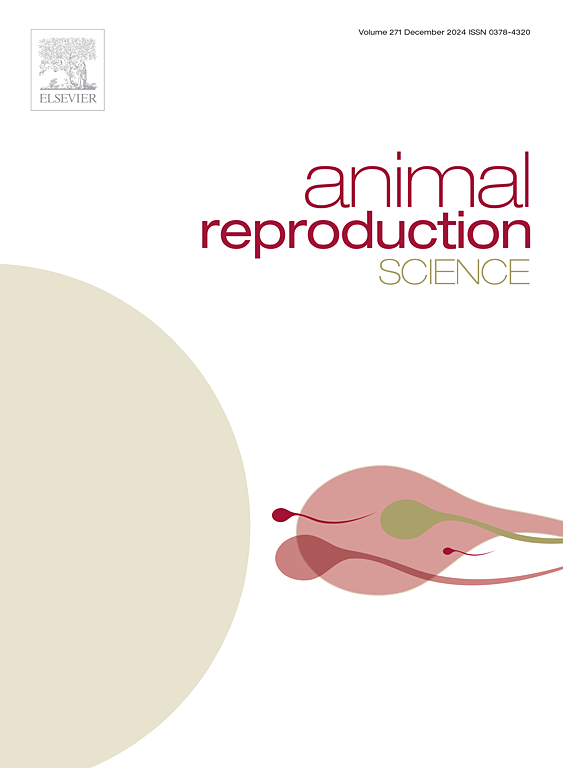Follicular fluid secretome enhances the meiotic competence of in vitro matured equine oocytes, but not the developmental competence of zygotes after intracytoplasmic sperm injection (ICSI)
IF 3.3
2区 农林科学
Q1 AGRICULTURE, DAIRY & ANIMAL SCIENCE
引用次数: 0
Abstract
In vitro embryo production is widely used in equine clinical reproduction; however, its efficiency remains suboptimal due to the undermined developmental competence of in vitro-matured oocytes. In this work, we evaluated the effect of mare preovulatory follicular fluid (PFF) secretome supplementation during in vitro maturation (IVM) of equine oocytes recovered post-mortem. Secretome was isolated from PFF and was added to the IVM medium at concentrations of 20 µg/ml (S20) or 40 µg/ml (S40). The percentage of mature oocytes, as well as embryo cleavage, blastocyst development, and gene expression of embryos produced by intracytoplasmic sperm injection (ICSI) was analysed. Gene expression of embryos at day 7 post-ICSI was analysed by real-time quantitative PCR. We observed that the addition of PFF secretome at 40 µg/ml (S40) significantly increased oocyte maturation rates (Control vs. S40: 35.4 ± 3.6 % vs. 46.5 ± 2.7 %; mean % ± SEM; P < 0.05) and reduced the proportion of degenerated oocytes after maturation (Control vs. S40: 58.6 ± 4.2 % vs. 44.0 ± 4.8 %; P < 0.05) compared to the control group. However, no effects were observed on cleavage or blastocyst rates, nor on the expression of the candidate genes studied, namely BEX2, FABP3, ODC, MOBKL3, HSP90AA1, BAX and BCL2. In conclusion, supplementation of PFF secretome during IVM at 40 µg/ml, but not at 20 µg/ml, improves the meiotic competence of post-mortem retrieved equine oocytes but does not influence their developmental competence or the expression of the selected genes in the resulting embryos.
卵泡液分泌组能提高体外成熟马卵母细胞的减数分裂能力,但不能提高卵浆内单精子注射(ICSI)后受精卵的发育能力。
体外胚胎生产广泛应用于马的临床生殖;然而,由于体外成熟卵母细胞的发育能力受到破坏,其效率仍然不理想。在这项工作中,我们评估了在马死后恢复的卵母细胞体外成熟(IVM)过程中补充马排卵前卵泡液(PFF)分泌组的影响。从PFF中分离分泌组,加入浓度为20 µg/ml (S20)或40 µg/ml (S40)的IVM培养基中。分析了胞浆内单精子注射(ICSI)产生的胚胎的成熟卵母细胞百分比、胚胎卵裂、囊胚发育和基因表达。采用实时荧光定量PCR分析icsi后第7天胚胎的基因表达。我们观察到,添加40 µg/ml (S40)的PFF分泌组显著提高了卵母细胞成熟率(对照与S40: 35.4 ± 3.6 % vs. 46.5 ± 2.7 %;平均值%±SEM;P <; 0.05),成熟后变性卵母细胞比例降低(对照组与对照组:58.6 ± 4.2 %对44.0 ± 4.8 %;P <; 0.05)。然而,未观察到对卵裂率或囊胚率的影响,也未观察到对候选基因BEX2、FABP3、ODC、MOBKL3、HSP90AA1、BAX和BCL2的表达的影响。综上所述,在体外受精过程中,添加40 µg/ml而不是20 µg/ml的PFF分泌组可以提高死后马卵母细胞的减数分裂能力,但不会影响它们的发育能力或所选基因在胚胎中的表达。
本文章由计算机程序翻译,如有差异,请以英文原文为准。
求助全文
约1分钟内获得全文
求助全文
来源期刊

Animal Reproduction Science
农林科学-奶制品与动物科学
CiteScore
4.50
自引率
9.10%
发文量
136
审稿时长
54 days
期刊介绍:
Animal Reproduction Science publishes results from studies relating to reproduction and fertility in animals. This includes both fundamental research and applied studies, including management practices that increase our understanding of the biology and manipulation of reproduction. Manuscripts should go into depth in the mechanisms involved in the research reported, rather than a give a mere description of findings. The focus is on animals that are useful to humans including food- and fibre-producing; companion/recreational; captive; and endangered species including zoo animals, but excluding laboratory animals unless the results of the study provide new information that impacts the basic understanding of the biology or manipulation of reproduction.
The journal''s scope includes the study of reproductive physiology and endocrinology, reproductive cycles, natural and artificial control of reproduction, preservation and use of gametes and embryos, pregnancy and parturition, infertility and sterility, diagnostic and therapeutic techniques.
The Editorial Board of Animal Reproduction Science has decided not to publish papers in which there is an exclusive examination of the in vitro development of oocytes and embryos; however, there will be consideration of papers that include in vitro studies where the source of the oocytes and/or development of the embryos beyond the blastocyst stage is part of the experimental design.
 求助内容:
求助内容: 应助结果提醒方式:
应助结果提醒方式:


